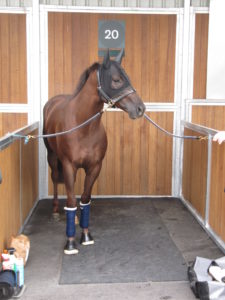It’s not often that the two-year-olds are the feature race of the day. But today is the day and I can even sleep in as the race is not off till 2.15 pm. But I’m early. I’m keen to check out Cannonball as this horse seems to have done a Lazarus and come back from the dead. When last observed in January 2010 (check out the search box!) he was an American horse ridden by the controversial Pat Valenzuela, who had previous convictions for substance abuse. Gosh, have I really been blogging on for that long? 12 years? Must be time soon to hang up the hat.

Cannonball
In the stalls the horse looks a million dollars. Well, $975,000 to be precise. So obviously it is not the American horse. In the yard the horse is frothy, dumping and is shitty behind. The favourite Yowie is a head up, changing gait, dumping horse, flashing me an occasional bit of white eye. In the end I decide it’s too hard and leave the race alone. Cannonball bursts to the front and holds them off for a strong win. In retrospect I probably should have laid Yowie, but my mind was stuck 12 years in the past.



Always makes you feel old when the names recycle…..esp if the initial thought is “I know this one, why’s it down in this class”?!
Dear Geoffrey,
I can see that you had the conundrum of a combination of behaviours!
A horse can choose to “evacuate” because it’s relaxed or perhaps because it’s feeling anxious or for some other reason. Shitty (pardon my French as my mother would say) suggests something of a more liquid nature. Is that a correct interpretation of shitty?
The behavioural handicap (BH) from Watching More Racehorses for shitty was 26. We don’t know whether the BH would be higher if it was confined to a sample of calm horses and lower for a sample of anxious/fractious horses although this would seem to make sense. As you say on page 172 of your first book the only way to unpick these combinations statistically would be a multivariable analysis (not for the faint hearted!) using data collected on a very large sample. But I assume we can always make a judgement based on how the horse is behaving overall and decide how to interpret this specific behaviour.
Onto a separate topic, on page 200 of Watching Racehorses you have a histogram which shows the behavioural handicap for All Horses and Winners. It shows that the BH works well for two year old races (2Y) open to colts, fillies and geldings? Why does strong dominant male behaviour not interfere with the behavioural handicap to the same degree in these races?
I was at the racetrack a couple of days ago where I saw what appeared to be indications of coltish behaviours in two races one confined to two-year old colts & geldings, and the other to three year old colts & geldings. Those horses exhibiting coltish behaviour did better. Is it best to steer clear of these types of races when coltish behaviour is observed amongst one or more horses?
Best wishes
Trevor
Dear Geoffrey
Some interesting recent observations at the racetrack before you venture off to sunnier climes (but don’t feel you have to respond).
A horse got loose, ran around the parade ring a couple of times before being caught when attempting to return down the alleyway to the racecourse stables. She was noticeably calmer in the mounting yard. She went onto win.
Another horse in a different race went from a very high to a low head carriage, into a prance with some neck arching before returning to a very high head carriage keeping this movement in the same vertical plane, and then repeating this quite a few times – have you seen that kind of head behaviour before? He finished 2nd.
Are lip chains a negative?
Sometimes you see a horse walk into the parade ring/mounting yard with a sense of purpose/confidence. There’s no obvious metric for this. I encountered such a horse the other day, unfortunately he finished 3rd of six (distances between the first four: hd, nk, nk in a two-mile race!), after suffering interference: waiting for room 2f out, soon not clear run, … a bit short of room final 110yds (the winner drifted right cutting off the route against the rail). The stewards’ enquiry went on for a long time, but the result was unchanged (stewards are loath to alter results here in the UK). You may well see some of these horses entered for the Melbourne Cup (Princess Zoe, Quickthorn, Enemy, Wordsworth). Princess Zoe, the winner, was sometimes a head down horse, but she had front bandages and whilst walking round the mounting yard her handler(strapper) said “Stop it”. The latter two observations put me off her somewhat.
Enjoy The Gold Coast, if you are heading in that direction for the Australian winter. As ever thanks for maintaining this blog, its much appreciated.
Trevor
1. Not that I remember. A feature of prancing is that is usually maintained for some time.
2. Yes.
3. The indefinable “presence”.
1. Yes, very liquid. And the high BH is still a conundrum!
2. Don’t know.
3. Yes.